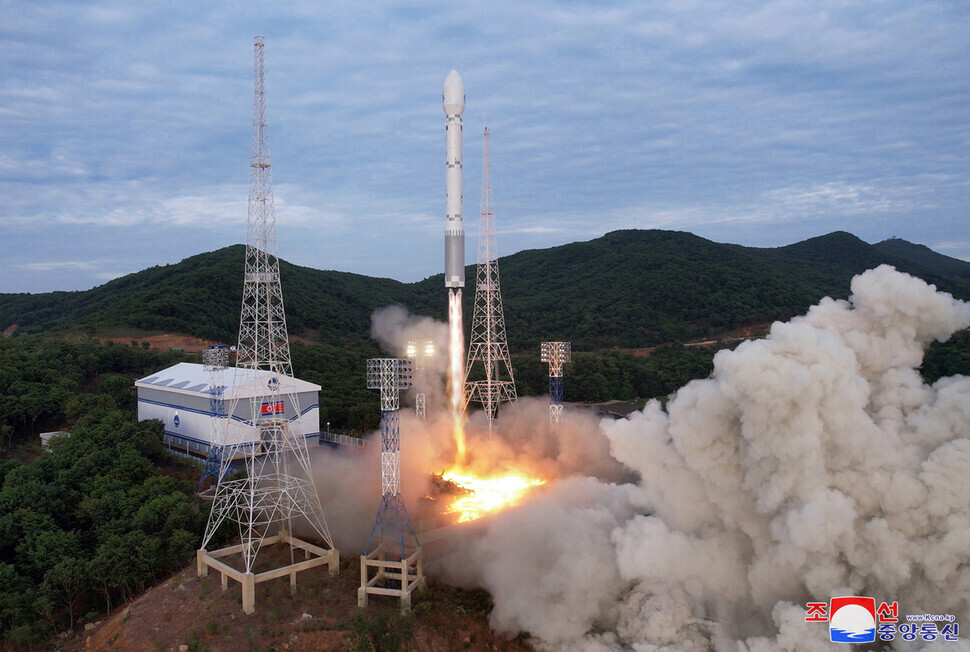hankyoreh
Links to other country sites 다른 나라 사이트 링크
After 2 successful satellite launches, why did N. Korea try again and fail?

On May 31, North Korea unsuccessfully attempted to launch a military reconnaissance satellite. Some were surprised that the North acknowledged the launch’s failure so quickly, but that wasn’t the first such acknowledgment since Kim Jong-un came to power. The bigger question is why the launch failed.
North Korea had already carried out two successful satellite launches, the first in December 2012 and the second in February 2016.
According to www.n2yo.com, a website providing information about satellites, both of the satellites that North Korea launched at the time — Kwangmyongsong-3 (KMS-3-2) and Kwangmyongsong-4 (KMS-4) — are still in orbit. KMS-3-2 rotates around the earth once every 92 minutes at an altitude of 372-388 kilometers, while KMS-4 completes a rotation every 90.5 minutes at an altitude of 309-318 kilometers.
Of course, whether those satellites are functioning properly is another question altogether.
But despite those successful satellite launches, North Korea tested a new rocket anyway. Why would it have done so, given the possibility of failure?
While it’s impossible to know for sure, this appears to have been an attempt to create a more effective satellite rocket than the one used seven years ago, drawing upon the technological expertise the North has accumulated while developing a series of new ballistic missiles under the rule of Kim Jong-un.
In December 2012, South Korean authorities recovered and analyzed the wreckage of the Eunha-3 rocket that launched the KMS-3-2 into space, from the waters west of the Korean Peninsula.
As a result, they found that the first stage of the Eunha rocket was designed to produce 120 tons of thrust with four Rodong missile engines.
This time, the South Korean military waded into the waters west of the peninsula once again to recover some of the wreckage of the Chollima-1 rocket that launched the Malligyong-1 satellite. One wonders what technology was used this time.
The North Koreans said immediately after the failed launch that they would conduct a second launch “as soon as possible.”
It’s unclear how soon “as soon as possible” will be, but it’s highly likely that it will take some time for North Korea to analyze the cause of the failure and fix any defects.
When North Korea first launched the KMS-3 in 2012, the second launch took place eight months after its first failure.
After the international community, including South Korea and the United States, condemned the launch as a “violation of UN Security Council resolutions,” Kim Yo-jong, the powerful sister of North Korean leader Kim Jong-un, responded by saying the UN Security Council’s resolution banning the use of ballistic missile technology is “gangster-like and wrong” in that it is “seriously violating the DPRK’s right to use space and illegally oppressing it.”
The ban on North Korea’s ballistic missile launches was first introduced in UN Security Council Resolution 1874, adopted in June 2009. The ban was imposed in response to North Korea’s launch of the KMS-2 and subsequent nuclear test, acknowledging the US’ argument that ballistic missiles are delivery vehicles for nuclear weapons and should be banned along with nuclear development.
In today’s political climate, China, a permanent member of the Security Council, would have vetoed the resolution, but at the time, China was not willing to risk confrontation with the superpower of the US on behalf of North Korea.
In any case, North Korea is the only country on earth that is strictly prohibited by a UN Security Council resolution from “any launch using ballistic missile technology,” so it’s understandable that it would feel unfair. However, it was North Korea itself that withdrew from the Treaty on the Non-Proliferation of Nuclear Weapons and conducted six nuclear tests despite international opposition.
By Park Byong-su, senior international affairs writer
Please direct questions or comments to [english@hani.co.kr]

Editorial・opinion
![[Column] Tariffs on China: Trump was dumb, Biden dumber [Column] Tariffs on China: Trump was dumb, Biden dumber](https://flexible.img.hani.co.kr/flexible/normal/500/300/imgdb/original/2024/0520/191716191153918.jpg) [Column] Tariffs on China: Trump was dumb, Biden dumber
[Column] Tariffs on China: Trump was dumb, Biden dumber![[Column] What if Seoul took reunification by force off the table? [Column] What if Seoul took reunification by force off the table?](https://flexible.img.hani.co.kr/flexible/normal/500/300/imgdb/original/2024/0520/3017161928630494.jpg) [Column] What if Seoul took reunification by force off the table?
[Column] What if Seoul took reunification by force off the table?- [Editorial] Intensifying US-China rivalry means Seoul must address uncertainty with Beijing sooner than later
- [Column] When ‘fairness’ means hate and violence
- [Editorial] Yoon must stop abusing authority to shield himself from investigation
- [Column] US troop withdrawal from Korea could be the Acheson Line all over
- [Column] How to win back readers who’ve turned to YouTube for news
- [Column] Welcome to the president’s pity party
- [Editorial] Korea must respond firmly to Japan’s attempt to usurp Line
- [Editorial] Transfers of prosecutors investigating Korea’s first lady send chilling message
Most viewed articles
- 1Xi, Putin ‘oppose acts of military intimidation’ against N. Korea by US in joint statement
- 2Kim Jong-un wanted to meet with residents of shelled Yeonpyeong Island in South, Moon recalls in mem
- 3To weigh costs and benefits, Korea must stop treating US troop presence as a sacred cow
- 4[Column] What if Seoul took reunification by force off the table?
- 5Berlin mayor hints at tearing down ‘comfort women’ memorial in city
- 6[Column] Tariffs on China: Trump was dumb, Biden dumber
- 7[Editorial] Transfers of prosecutors investigating Korea’s first lady send chilling message
- 8[Exclusive] Truth commission to seek additional murder charges for figures behind 1980 Gwangju massa
- 9Naver’s union calls for action from government over possible Japanese buyout of Line
- 10[Column] US troop withdrawal from Korea could be the Acheson Line all over